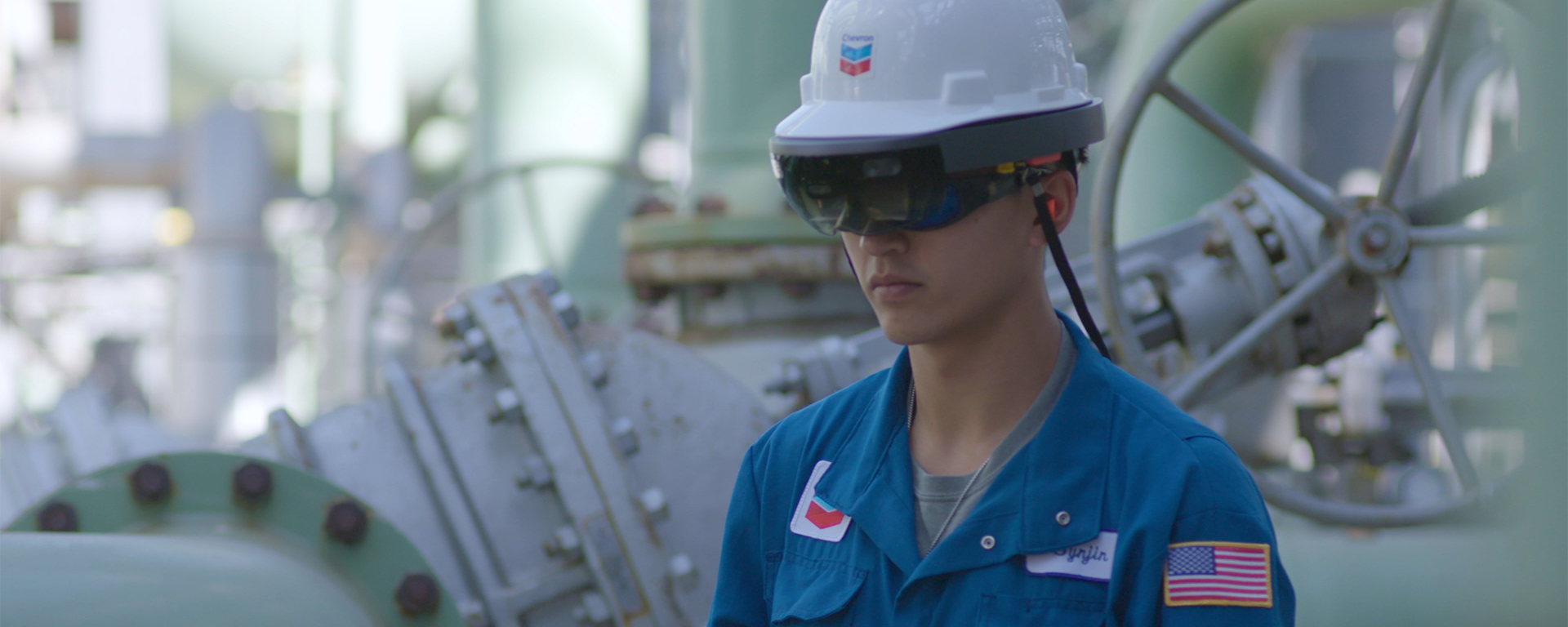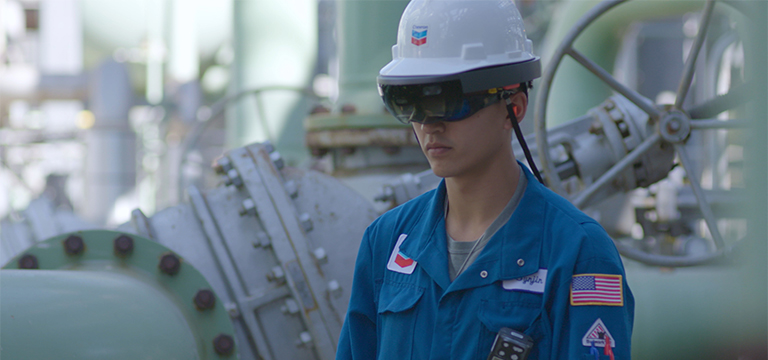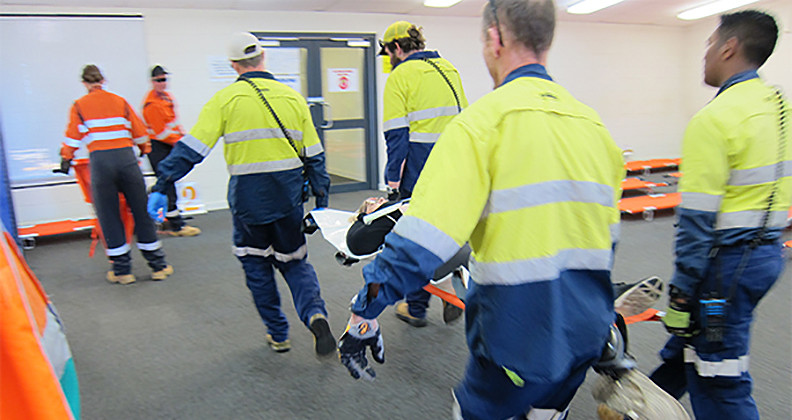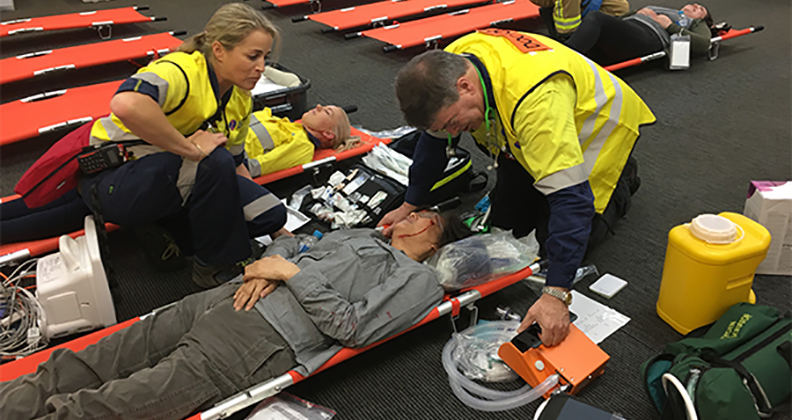

feature
how we learned from NASA and the Microsoft HoloLens team to make virtual teleportation a reality
A technology called HoloLens is showing us that the future is now, as it makes sci-fi virtual teleporting a business reality for safer operations and to address issues more quickly on the Chevron front lines.
HoloLens, a headset that operates as a fully self-contained holographic computer, coupled with Microsoft Dynamics 365 remote assist, enables users to troubleshoot problems by connecting field personnel with subject experts located around the world.
Our use of this technology is derived from NASA’s prior adoption of similar remote collaboration between earth and space on the International Space Station Project. Learning from NASA’s experience, Chevron technical experts foresee many potential ways to work with business units to remotely solve design, operational and other technical problems to ensure a facility’s ongoing reliable operations – all without incurring expensive, time-consuming travel.
microsoft and chevron team up to deploy hololens AR technology
how the microsoft hololens works
A worker in a field location simply dons the HoloLens headset that is attached to a hardhat. The HoloLens is a wearable Windows 10 PC with a camera, microphone and speakers built into the headset and connects onto the Chevron network via internet connection. The remote expert, who might also be at home depending on the time of day, can see on his or her computer monitor exactly what the field-based representative is seeing and guide him or her step-by-step through a resolution, thereby increasing efficiency and effectiveness. “In addition to seeing each other, the HoloLens allows the user and the remote expert to share data – such as manuals and drawings - at the press of a button,” said Bisram “Sam” Samlall, Technology & Innovation team lead at El Segundo Refinery. “And they can ‘draw’ on what they are seeing in full three dimensions.”
“Our use of HoloLens’ remote expert technology in an increasing number of our business units demonstrates our Chevron Way value of differentiating our performance through technology,” said John O’Brien, R&D Portfolio Manager, ETC Facilities Engineering Department. “HoloLens can reduce travel and stress, improve safety and enable experts to work in a collaborative space for fabrication and other tasks.”
Facilities Engineering recently developed a proof of concept (PoC) program using HoloLens at the expansion project of the Jack/St. Malo field in the U.S. Gulf of Mexico. Design engineers took 3-D models of the designs and holographically projected them at full scale into a conference room. These dimensionally precise holograms allowed them to see exactly what the model would look like and test for clearance, safety and other design issues before a single part was fabricated.
“This tool allows you to gain a much better and more practical perspective of the model and allows you to physically reach up or bend over to access valves and other equipment.”
Ed Moore
Senior Technology Strategist, Chevron Energy Technology Company (ETC)
“The Operations team was very excited about being able to get a physical understanding of their surroundings in the model for checking the maintainability and operability of equipment.”
The proof of concept helped to establish that HoloLens can be used effectively both in fabrication yards and offshore and has capabilities for field verification during construction and in brownfield environments.
“You can overlay the model onto a skid in the fabrication yard — or offshore on the floating production unit — to conduct verifications,” said Gary Fischer, general manager, Special Projects, Project Resources Company. “It allows the user to quickly identify potential design or safety concerns. And it’s very helpful to be able to pull up datasheets, piping and instrumentation diagrams, and other relevant documentation for whatever you’re trying to troubleshoot in the field.”

Crews on Barrow Island performing a casualty clearing post exercise.
ensuring quality control with the microsoft hololens
Our Lubricants business is currently using HoloLens to ensure quality control and safe operations at its Ghent, Belgium, and Louisville, Ky., plants. “Our goal is to deploy HoloLens at all of our plants to ensure quality and safety objectives are met,” said Tim Brong, process control system coordinator for Supply Chain & Base Oils Operations.
Jeff Kendall, regional engineer at the Louisville Marketing Terminal, described a pilot during which his team used HoloLens to scan a specific area of the plant where they were concerned about safe and effective access. “We were installing piping in a tight area of the blending operations and we wanted to be sure that we would have enough clearance for forklift operations. HoloLens makes reality come alive enabling us to see things you could never see otherwise.”
providing onsite expertise with the microsoft hololens
Our Australasia business unit’s (ABU’s) Information Systems team has been running field trials with the HoloLens on Western Australia’s Barrow Island to help provide remote expert support.

Crews on Barrow Island perform an exercise for a casualty clearing post where a waiting room at an airport is cleared out and then used to group injured workers by the severity of their injuries.
Dr. Max Hills, ABU’s chief medical officer, is testing HoloLens for incident response and tracking people in the event of an emergency. Dr. Hills said that when patients are brought into makeshift treatment areas following an incident, “Holographic signs above each patient saying who they are and what is wrong is useful for emergency medical care and facilitates handover between medical personnel.”
John O’Brien said that HoloLens’ use is spreading throughout the company, with more than 100 devices currently available. “There are so many potential applications for HoloLens,” he said. “For example, El Segundo Refinery is considering using the technology to provide a 3-D view for space planning throughout the facility. It’s like having a model of a house in which you can place the furniture around each room and see how it will fit. In the case of the refinery, if you have a new compressor, HoloLens enables you to determine the best location for it. HoloLens’ 3-D model of the refinery helps you make efficiency use of crews, helps you with traffic control, and makes you much more efficient and safer. And this is just the beginning of the technology’s applications.”
Published: December 2018
